Which Measure Of Central Tendency Is Most Affected By Outliers
Kalali
May 09, 2025 · 3 min read

Table of Contents
Which Measure of Central Tendency is Most Affected by Outliers?
Understanding central tendency is crucial in statistics, helping us summarize data by identifying its center. We commonly use three measures: mean, median, and mode. However, these measures react differently to the presence of outliers – extreme values that significantly deviate from the rest of the data. This article will explore which measure is most susceptible to these outliers and why. Choosing the appropriate measure depends heavily on the nature of your dataset and the insights you seek to derive.
What are Outliers?
Outliers are data points that fall significantly outside the typical range of values in a dataset. They can occur due to various reasons, such as measurement errors, data entry mistakes, or simply representing truly unusual observations. Identifying and handling outliers is a key step in data analysis to prevent skewed results.
The Three Measures of Central Tendency:
-
Mean: The mean, or average, is calculated by summing all data points and dividing by the number of data points. It's straightforward to calculate but highly sensitive to outliers. A single extreme value can drastically shift the mean, misrepresenting the typical value.
-
Median: The median is the middle value when data is ordered from least to greatest. If there's an even number of data points, the median is the average of the two middle values. The median is far less affected by outliers because it focuses on the position of the data points rather than their values.
-
Mode: The mode is the most frequent value in a dataset. It's useful for categorical data but less so for continuous data where values are unlikely to repeat exactly. Outliers have minimal to no effect on the mode.
How Outliers Impact Each Measure:
Let's illustrate with a simple example. Consider the following dataset representing the ages of attendees at a conference: 25, 27, 28, 29, 30, 32, 75. The value 75 is a clear outlier.
-
Mean: The mean is (25+27+28+29+30+32+75)/7 = 36.4. The outlier significantly inflates the mean, making it a poor representation of the typical attendee age.
-
Median: Ordering the data gives us 25, 27, 28, 29, 30, 32, 75. The median is 29, which is much closer to the majority of the data points and unaffected by the outlier.
-
Mode: There is no mode in this dataset, as no value is repeated.
Conclusion: The Mean is Most Affected
From this example and general statistical principles, it's clear that the mean is the measure of central tendency most affected by outliers. While the median and mode remain relatively stable, the mean is highly susceptible to distortion by extreme values. Therefore, when dealing with datasets that might contain outliers, the median is often a more robust and reliable measure of central tendency to describe the typical value. Understanding the strengths and weaknesses of each measure is crucial for accurate data interpretation and effective decision-making. Choosing the right measure depends heavily on the context of your data and the specific insights you want to extract. Consider the nature of your data and the presence of potential outliers when selecting your central tendency measure.
Latest Posts
Latest Posts
-
Will A Fishs Fin Grow Back
May 09, 2025
-
What Is The Main Cause Of Any Change Of State
May 09, 2025
-
Cuanto Es 3 Metros En Pulgadas
May 09, 2025
-
What Is The Lcm Of 5 And 15
May 09, 2025
-
5 Out Of 7 Is What Percentage
May 09, 2025
Related Post
Thank you for visiting our website which covers about Which Measure Of Central Tendency Is Most Affected By Outliers . We hope the information provided has been useful to you. Feel free to contact us if you have any questions or need further assistance. See you next time and don't miss to bookmark.